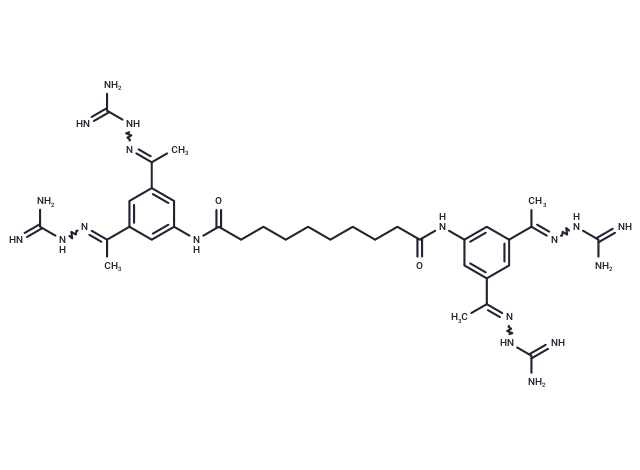Shopping Cart
- Remove All
 Your shopping cart is currently empty
Your shopping cart is currently empty

Semapimod is an inhibitor of proinflammatory cytokine production, capable of suppressing TNF-α, IL-1β, and IL-6. It hinders TLR4 signaling with an IC50 of approximately 0.3 μM, impedes p38 MAPK, and reduces nitric oxide production in macrophages. This compound shows promise for treating various inflammatory and autoimmune disorders [1] [2] [3].

| Pack Size | Price | Availability | Quantity |
|---|---|---|---|
| 25 mg | $1,520 | 6-8 weeks | |
| 50 mg | $1,980 | 6-8 weeks | |
| 100 mg | $2,500 | 6-8 weeks |
| Description | Semapimod is an inhibitor of proinflammatory cytokine production, capable of suppressing TNF-α, IL-1β, and IL-6. It hinders TLR4 signaling with an IC50 of approximately 0.3 μM, impedes p38 MAPK, and reduces nitric oxide production in macrophages. This compound shows promise for treating various inflammatory and autoimmune disorders [1] [2] [3]. |
| In vitro | Semapimod induces a notable decrease in the phosphorylation of p38-MAPK, the pro-inflammatory gene expression of macrophage inflammatory protein-1alpha, interleukin-6, monocyte chemoattractant protein-1, and intercellular adhesion molecule-1 in macrophages, as well as reducing neutrophil infiltration. It completely abolishes nitric oxide production within the muscular layer [2]. Through its effect on the TLR co-chaperone protein gp96, Semapimod desensitizes TLR signaling. In vitro, Semapimod tetrahydrochloride inhibits the ATP binding and ATPase activity of gp96 (IC 50 ≈0.2-0.4 μM). This desensitization of TLR signaling is due to its impact on the TLR molecular co-chaperone gp96 [3]. Semapimod (0-500 nM) suppresses the invasion of GL261 stimulated by microglia [4]. However, Semapimod (0-10 µM) does not affect the invasion of glioma cells stimulated by serum, highlighting its selectivity for the monocytic lineage, even at concentrations as high as 10 µM [4]. Furthermore, at a concentration of 200 nM, Semapimod does not impact the proliferation of glioma cells stimulated by microglia [4]. |
| In vivo | Semapimod at a dosage of 5 mg/kg administered intraperitoneally once daily for two weeks improved endothelial dysfunction in Obese Zucker (OZ) rats [1]. This compound restored adrenomedullin (AM)-induced phosphorylation of akt and production of cyclic guanosine monophosphate (cGMP) in these rats [1]. Additionally, Semapimod, at a concentration of 6 mg/kg/day delivered intracranially for one week, inhibited the invasion of glioblastoma cells in vivo [4]. When combined with radiotherapy, intracranial administration of Semapimod over two weeks significantly enhanced survival rates in GL261 tumor-bearing animals, with no marked benefit observed in the absence of radiotherapy [4]. |
| Alias | CPSI-2364, CNI-1493 free base |
| Molecular Weight | 744.9 |
| Formula | C34H52N18O2 |
| Cas No. | 352513-83-8 |
| Storage | Powder: -20°C for 3 years | In solvent: -80°C for 1 year | Shipping with blue ice. |

Copyright © 2015-2025 TargetMol Chemicals Inc. All Rights Reserved.